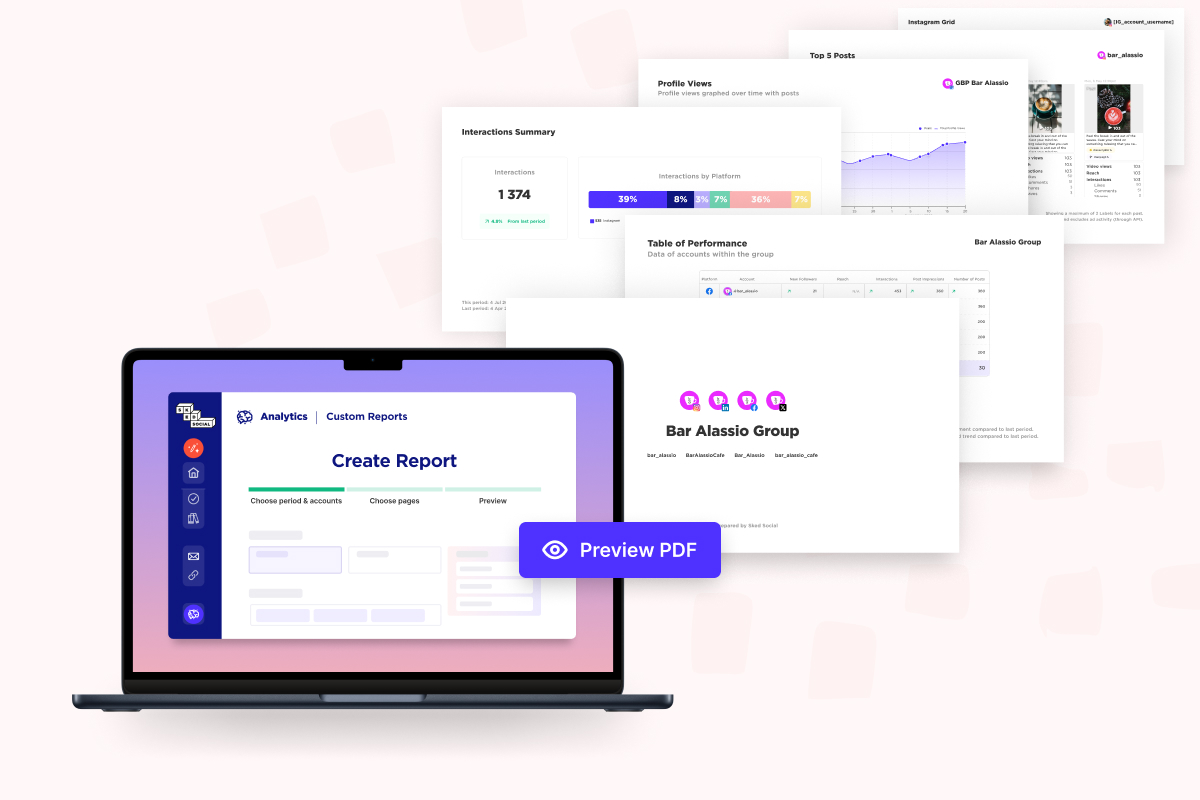Features
Why Sked?
More
Sked Social is a third party app and is not affiliated with or endorsed by any social network platforms.
See our Terms & Privacy Policy.
See our Terms & Privacy Policy.
© 2025 Sked Social. All rights reserved.

Let's face it—creating social media reports that actually mean something isn't just about dumping numbers into a pretty template. Your clients need reports that tell a real story about what's working, what's not, and where to go next.
With over 5.2 billion people using social media in 2025, the competition for attention is fierce. That's why you need reporting that goes beyond vanity metrics and delivers genuine insights. Here's what every killer client report should include.
Skip the fluff and get straight to the point. Your executive summary should answer the big question: "Are we winning?" in under 30 seconds. Include:
Think of it as the elevator pitch for your social media work—concise, clear, and compelling.
Each social platform is its own beast. What crushes on TikTok might flop on LinkedIn. Break down performance by platform because context is everything:
Don't lump everything together—your client needs to understand where their content shines and where it needs work.
Age and location data? That's table stakes. Dig deeper into:
This intel helps you optimize posting schedules and content types for maximum impact.
Show which content types are absolute gold and which ones are falling flat. Engagement is the clearest indicator of how well your content resonates with your audience, so break down:
This section should be your content strategy roadmap for the coming month.
Your clients want to know how they stack up. Include competitive benchmarking that shows:
Social media analytics tools like Sked Social reveal exactly how competitors engage their audiences, including what they post, which formats get the best response, and how those interactions trend over time.
Your new all-in-one workspace where brainstorms actually turn into content. Capture ideas when they hit, work with your team, fill the gaps in your calendar, and let AI handle the heavy lifting—from concept to publish. Get early access today.
Get Early Access!This is where you prove your worth. Connect social activity to real business outcomes:
Follower count is nice, but community health tells the real story:
Don't just report what happened—tell them what to do next. Include:
Make your recommendations specific and actionable, not vague suggestions.
Charts and graphs should tell stories, not confuse people. Use:
In 2025, top tools auto-generate polished, board-ready reports—complete with insights like "Video content drove 73% of Q3 leads".
End every report looking forward, not backward. Based on your data, outline:
The best social media analytics tools and best social media management tools for agencies make this process seamless. When you're comparing social media reporting tools, look for platforms that offer:
Sked Social makes creating these comprehensive reports a breeze. With Sked's deep analytics (plus a little AI brainpower) show you what's working and where to double down, you get:
Yes! Sked supports custom and white label reporting for agencies! Use our Custom Reports to create one-off or recurring reports tailored to clients or stakeholders, delivered straight to your email. Plus, you get our pro-level AI summaries that you can send as is, or edit to personalize the commentary to your client or stakeholder.

The best social media scheduling tools and social media monitoring tools for agencies integrate seamlessly with reporting, so you're not juggling multiple platforms. Sked Social combines powerful social media planning tools with robust analytics in one affordable package.
Your social media reports should spark conversations, drive decisions, and prove ROI. They're not just data dumps—they're strategic documents that guide your client's social media success.
Ready to create reports that actually matter? Start your free 7-day trial with Sked Social and see how easy comprehensive social media reporting can be. With unlimited users, AI-powered insights, and custom reporting features, you'll spend less time pulling numbers and more time driving client results.